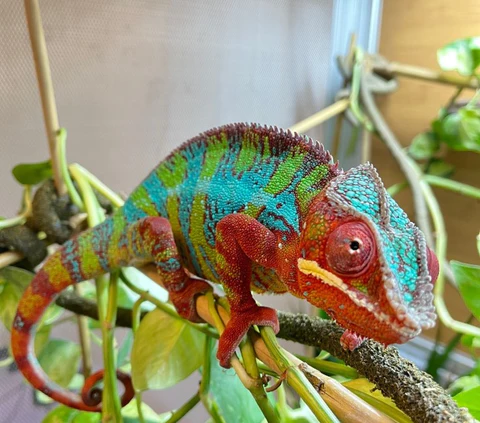
Description:
Scientific name: Furcifer pardalis
Life span: 2-7 years
Panther chameleons can reach lengths of 16 to 20 inches (40 to 51 cm), with females often being shorter than males. A type of sexual dimorphism occurs when males have more vivid colors than females. Location affects coloration, and the various color patterns of panther chameleons are known as “locales,” which are named after the areas where they can be found.
Native Region/Habitat
Panther chameleons are found widely in lowland regions of the eastern and northeastern parts of the country. They are native to Madagascar. It has also been introduced to Mauritius and Réunion.
The eastern rainforest and drier broken forest/savannah habitats are where the panther chameleon can be found.

Behavior:
The panther chameleon is extremely territorial and spends the most of its time alone, excluding breeding season. In an effort to establish dominance, two males will alter their colors and enlarge their bodies when they come into contact. At this point, many battles come to a conclusion with the loser retreating and changing to dull and gloomy colors. Occasionally, if neither contestant yields, the displays devolve into physical conflict.
Care As a pet/In captivity:
Habitat size:
Because chameleons are arboreal, it is best to provide a vertically oriented habitat with an area for climbing that is the right size and shape to suit regular activity. As long as proper temperature and humidity levels can be maintained, it is ideal to keep chameleons individually in tanks with good ventilation or habitats that are mesh or screened, with tightly fitting lids to prevent escape. A single adult needs an enclosure that is at least 24″ L x 24″ W x 36″ H in size. In ideal circumstances, panther chameleons achieve their full size after 12 months.
Humidity:
Panther chameleons need a habitat humidity of 50–60% during the day and 75–100% at night in order to maintain sufficient hydration and shed. Monitor humidity levels using a humidity gauge. Spraying the enclosure many times, each day will aid in humidity maintenance.
Commercial drip systems, misters, and bubblers may also be used, provided that they are cleaned with diluted bleach once or twice a month and completely rinsed to prevent the growth of germs and mold, which could result in serious health issues. Avoid using humidifiers because they are particularly notorious for fostering the growth of germs.
Temperature:
Provide a temperature gradient in the habitat so that chameleons, who are ectotherms (animals that regulate their body temperatures in response to external temperatures), can roam around and do so.
The warm part of the day should have temperatures between 95 and 100 degrees Fahrenheit, while the cool end should have temperatures between 80 and 65 degrees Fahrenheit. Use at least two thermometers to keep an eye on the temperature—one in the cold area and the other in the hot (basking) area.
An incandescent or ceramic heat bulb can offer heat. Thermostats should be connected to heat sources to control temperatures. Because they can burn reptiles, hot rocks should never be utilized as a source of heat.
Diet:
A variety of live insects, including gut-loaded (recently fed) crickets, mealworms, calci-worms, Dubia roaches, superworms, flies, silkworms, butterworms, hornworms, earthworms, and waxworms, make up a healthy panther chameleon diet.
Table





